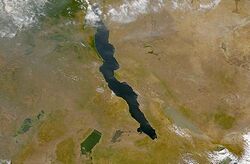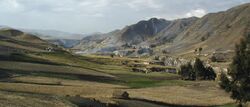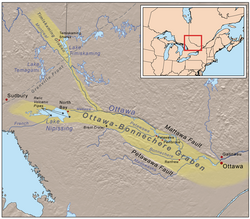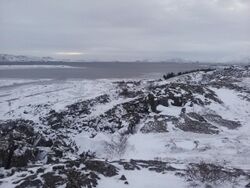Earth:Rift valley




A rift valley is a linear shaped lowland between several highlands or mountain ranges produced by the action of a geologic rift. Rifts are formed as a result of the pulling apart of the lithosphere due to extensional tectonics. The linear depression may subsequently be further deepened by the forces of erosion. More generally the valley is likely to be filled with sedimentary deposits derived from the rift flanks and the surrounding areas. In many cases rift lakes are formed. One of the best known examples of this process is the East African Rift.[1] On Earth, rifts can occur at all elevations, from the sea floor to plateaus and mountain ranges in continental crust or in oceanic crust. They are often associated with a number of adjoining subsidiary or co-extensive valleys, which are typically considered part of the principal rift valley geologically.
Earth's rift valleys
The most extensive rift valley is located along the crest of the mid-ocean ridge system and is the result of sea floor spreading. Examples of this type of rift include the Mid-Atlantic Ridge and the East Pacific Rise.
Many existing continental rift valleys are the result of a failed arm (aulacogen) of a triple junction, although there are two, the East African Rift and the Baikal Rift Zone, which are currently active, as well as a third which may be, the West Antarctic Rift System. In these instances, not only the crust but entire tectonic plates are in the process of breaking apart forming new plates. If they continue, continental rifts will eventually become oceanic rifts.
Other rift valleys are the result of bends or discontinuities in horizontally-moving (strike-slip) faults. When these bends or discontinuities are in the same direction as the relative motions along the fault, extension occurs. For example, for a right lateral-moving fault, a bend to the right will result in stretching and consequent subsidence in the area of the irregularity. In the view of many geologists today, the Dead Sea lies in a rift which results from a leftward discontinuity in the left lateral-moving Dead Sea Transform fault. Where a fault breaks into two strands, or two faults run close to each other, crustal extension may also occur between them, as a result of differences in their motions. Both types of fault-caused extension commonly occur on a small scale, producing such features as sag ponds or landslides.
Rift valley lakes
Many of the world's largest lakes are located in rift valleys.[2] Lake Baikal in Siberia, a World Heritage Site,[3] lies in an active rift valley. Baikal is both the deepest lake in the world and, with 20% of all of the liquid freshwater on earth, has the greatest volume.[4] Lake Tanganyika, second by both measures, is in the Albertine Rift, the westernmost arm of the active East African Rift. Lake Superior in North America, the largest freshwater lake by area, lies in the ancient and dormant Midcontinent Rift. The largest subglacial lake, Lake Vostok, may also lie in an ancient rift valley.[5] Lake Nipissing and Lake Timiskaming in Ontario and Quebec, Canada lie inside a rift valley called the Ottawa-Bonnechere Graben.[6] Þingvallavatn, Iceland's largest natural lake, is also an example of a rift lake.
Extraterrestrial rift valleys
Rift valleys are also known to occur on other terrestrial planets and natural satellites. The 4,000 km long Valles Marineris on Mars is believed by planetary geologists to be a large rift system.[7][8] Some features of Venus, most notably, the 4,000 km Devana Chasma[9] and a part of the western Eistla, and possibly also Alta and Bell Regio have been interpreted by some planetary geologists as rift valleys.[10][11] Some natural satellites also have prominent rift valleys. The 2,000 km long Ithaca Chasma on Tethys in the Saturn system is a prominent example. Charon's Nostromo Chasma is the first confirmed in the Pluto system, however large chasms up to 950 km wide observed on Charon have also been tentatively interpreted by some as giant rifts, and similar formations have also been noted on Pluto.[12] A recent study suggests a complex system of ancient lunar rift valleys, including Vallis Rheita and Vallis Alpes.[13] The Uranus system also has prominent examples, with large 'chasma' believed to be giant rift valley systems, most notably the 1492 km long Messina Chasma on Titania, 622 km Kachina Chasmata on Ariel, Verona Rupes on Miranda,[14] and Mommur Chasma on Oberon.[15]
References
- ↑ "The Ethiopian Rift Valley". Giacomo Corti-CNR. http://ethiopianrift.igg.cnr.it.
- ↑ "The World's Greatest Lakes". https://www.schoolofflyfishing.com/worlds-greatest-lakes/.
- ↑ "Lake Baikal – World Heritage Site". World Heritage. https://whc.unesco.org/en/list/754.
- ↑ "The Oddities of Lake Baikal". Alaska Science Forum. http://www.gi.alaska.edu/ScienceForum/ASF9/986.html.
- ↑ Siegert, Martin J. (1999). "Antarctica's Lake Vostok". American Scientist 87 (6): 510. doi:10.1511/1999.6.510. Bibcode: 1999AmSci..87..510S. "The best explanation is that Lake Vostok may lie in a rift valley, as does Lake Tanganyika in East Africa and Lake Baikal in Russia. The geography of Lake Vostok is indeed consistent with this notion, in that the lake has a crescent shape, just like Tanganyika and Baikal, and the side walls of the lake are relatively steep, at least on one side.".
- ↑ John Grotzinger .... (2006). Understanding Earth.. New York: W. H. Freeman. ISBN 0-7167-7696-0.
- ↑ Anderson, Scott; Grimm, Robert E. (1998). "Rift processes at the Valles Marineris, Mars: Constraints from gravity on necking and rate-dependent strength evolution". Journal of Geophysical Research 103 (E5): 11113. doi:10.1029/98JE00740. ISSN 0148-0227. Bibcode: 1998JGR...10311113A.
- ↑ Andrews-Hanna, Jeffrey C. (2012). "The formation of Valles Marineris: 3. Trough formation through super-isostasy, stress, sedimentation, and subsidence". Journal of Geophysical Research 117 (E6): n/a. doi:10.1029/2012JE004059. ISSN 0148-0227. Bibcode: 2012JGRE..117.6002A.
- ↑ Kiefer, W. S.; Swafford, L. C. (2006). "Topographic Analysis Of Devana Chasma, Venus; Implications For Rift System Segmentation And Propagation". Journal of Structural Geology 28 (12): 2144–2155. doi:10.1016/j.jsg.2005.12.002. Bibcode: 2006JSG....28.2144K.
- ↑ Senske, D. A.; Schaber, G. G.; Stofan, E. R. (1992). "Regional topographic rises on Venus: Geology of Western Eistla Regio and comparison to Beta Regio and Atla Regio". Journal of Geophysical Research 97 (E8): 13395. doi:10.1029/92JE01167. ISSN 0148-0227. Bibcode: 1992JGR....9713395S.
- ↑ Solomon, Sean C.; Smrekar, Suzanne E.; Bindschadler, Duane L.; Grimm, Robert E.; Kaula, William M.; McGill, George E.; Phillips, Roger J.; Saunders, R. Stephen et al. (1992). "Venus tectonics: An overview of Magellan observations". Journal of Geophysical Research 97 (E8): 13199. doi:10.1029/92JE01418. ISSN 0148-0227. Bibcode: 1992JGR....9713199S.
- ↑ Dunn, Marcia (16 July 2015). "'Blowing my mind': Peaks on Pluto, canyons on Charon". PhysOrg. http://phys.org/news/2015-07-mind-peaks-pluto-canyons-charon.html.
- ↑ Andrews-Hanna, Jeffrey C.; Besserer, Jonathan; Head III, James W.; Howett, Carly J. A.; Kiefer, Walter S.; Lucey, Paul J.; McGovern, Patrick J.; Melosh, H. Jay et al. (2014). "Structure and evolution of the lunar Procellarum region as revealed by GRAIL gravity data". Nature 514 (7520): 68–71. doi:10.1038/nature13697. ISSN 0028-0836. PMID 25279919. Bibcode: 2014Natur.514...68A.
- ↑ Chaikin, Andrew (2001-10-16). "Birth of Uranus' provocative moon still puzzles scientists". space.com. Imaginova Corp. pp. 1. http://www.space.com/scienceastronomy/solarsystem/miranda_creation_011016-1.html.
- ↑ Smith, B. A.; Soderblom, L. A.; Beebe, A.; Bliss, D.; Boyce, J. M.; Brahic, A.; Briggs, G. A.; Brown, R. H. et al. (4 July 1986). "Voyager 2 in the Uranian System: Imaging Science Results". Science 233 (4759): 43–64. doi:10.1126/science.233.4759.43. PMID 17812889. Bibcode: 1986Sci...233...43S. https://zenodo.org/record/1230972.
Further reading
- Bonatti, E (1985). "Punctiform initiation of seafloor spreading in the Red Sea during transition from a continental to an oceanic rift". Nature 316 (6023): 33–37. doi:10.1038/316033a0. Bibcode: 1985Natur.316...33B.
- Mart, Y.; Dauteuil, O. (2000). "Analogue experiments of propagation of oblique rifts". Tectonophysics 316 (1–2): 121–132. doi:10.1016/s0040-1951(99)00231-0. Bibcode: 2000Tectp.316..121M.
 |
